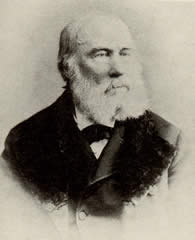Walter Hood Fitch

Walter Hood Fitch (born February 28, 1817 in Glasgow , † January 14, 1892 in Kew ) was a Scottish botanical illustrator who made nearly 10,000 lithographs for various scientific publications. These include 2,700 colored works for Curtis's Botanical Magazine , for which he produced up to 200 plates per year.
Life

Born in Glasgow, he first worked as a fabric printing apprentice and pattern draftsman in a calico textile company for Kaliko printers. After work he helped William Jackson Hooker assemble plant specimens on herbarium sheets and in his spare time he drew flowers. Hooker soon recognized Fitch's drawing skills and asked him to help him with botanical illustrations. As a result of this cooperation, Hooker bought him out of his apprenticeship around 1830.
The hardworking Fitch had developed a particularly bold way of letting his illustrations work out of his stuff printing apprenticeship, which soon became noticeable in the botanical pictures. From 1834 on, Fitch took over from Hooker, his post as chief illustrator of Curtis's Botanical Magazine . He held the position until 1877, when he worked as chief lithographer for 43 years and produced several thousand illustrations, which made him the most important and by far the most productive plant illustrator not only of the Victorian era, but also in general.
Over the long period, Fitch was not only employed by the later director of the Royal Botanic Garden, Kew, Joseph Dalton Hooker for the illustrations, he was almost exploited in it because he made over 9,900 illustrations, but received little money for them, which in 1877 broke led with Hooker when Fitch wanted better pay. This large yield of qualitatively unique color lithographs that Fitch published at this time was only possible through the invention of the new technology in flat form, which completely replaced older carving and engraving techniques.
After 1841, Fitch became the sole artist for Kew's official and unofficial publications. Hooker paid Fitch personally for this. He was able to draw for various publications simultaneously and often produced his illustration directly on the lithographic limestone slabs to save time.
In addition to his illustrations for scientific works, Fitch worked on popular flower coloring books of the higher society. In 1869 he published a series of articles on flower drawing in the Gardener's Chronicle .
Although Joseph Dalton Hooker and Fitch had parted in disagreement, Hooker then sought the welfare of Fitch. Hooker asked the then most powerful man in the British Empire, Prime Minister Benjamin Disraeli , to donate Fitch an annual honorary salary for his services in botanical illustration. Disraeli hesitated and Hooker showed him some of the large lithographs of the water lily Victoria regia , whereupon Fitch was awarded an honorary salary of 100 British pounds per year from 1879.
Work
In addition to Fitch's work in Botanical Magazine , his illustration of Henry John Elwes ' lily monograph and other works are outstanding.
Web links
credentials
- ↑ Kew Heritage: Walter Hood Fitch (1817-1892) ( Memento of the original from January 29, 2009 in the Internet Archive ) Info: The archive link was inserted automatically and has not yet been checked. Please check the original and archive link according to the instructions and then remove this notice.
- ^ William T. Stearn 1990: Flower Artists of Kew . The Herbert Press in association with The royal Botanic Gardens, Kew, London. ISBN 1-871569-16-8 , p. 28
- ^ Jack Kramer 2002: The Art of flowers . Watson Guptill Publications, New York. ISBN 0-8230-0311-6 , p. 152
- ^ William T. Stearn 1990: Flower Artists of Kew . The Herbert Press in association with The royal Botanic Gardens, Kew, London. ISBN 1-871569-16-8 , p. 27
- ^ William T. Stearn 1990: Flower Artists of Kew . P. 27
| personal data | |
|---|---|
| SURNAME | Fitch, Walter Hood |
| BRIEF DESCRIPTION | Scottish botanical illustrator |
| DATE OF BIRTH | February 28, 1817 |
| PLACE OF BIRTH | Glasgow |
| DATE OF DEATH | January 14, 1892 |
| Place of death | Kew |
